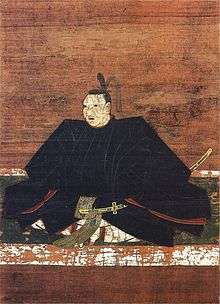Sō Yoshitoshi
| Sō Yoshitoshi | |
|---|---|
 Portrait of Sō Yoshitoshi in 1615 | |
| Daimyō of Tsushima | |
|
In office 1588–1615 | |
| Preceded by | Sō Yoshishige |
| Succeeded by | Sō Yoshinari |
| Personal details | |
| Born |
January 1, 1568 Japan |
| Died |
January 31, 1615 (aged 47) Tsushima, Japan |
| Nationality | Japanese |
| Spouse(s) | Konishi Maria |

Sō Yoshitoshi (宗 義智, 1568 – 31 January 1615) was a Sō clan daimyō (feudal lord) of the domain of Tsushima on Tsushima Island at the end of Japan's Sengoku period, and into the Edo period. His name is sometimes read as Yoshitomo.[1] Under the influence of Konishi Yukinaga, he was baptized and accepted the name "Dario". He took part in Toyotomi Hideyoshi's invasions of Korea in the 1590s, and led a force in the Siege of Busan.
The Sō clan did not participate in the Battle of Sekigahara in 1600;[1] however, the tozama Sō clan were allowed to continue to rule Tsushima.[2]
Early life
Yoshitoshi was the fifth son of Sō Masamori; his wife, who took the baptismal name Maria, was the daughter of Konishi Yukinaga. Yoshitoshi became the head of the family in 1580, after his adoptive father, Sō Yoshishige, was defeated, and Tsushima conquered, in a prelude to Toyotomi Hideyoshi's Kyūshū Campaign. Yoshitoshi thus entered Hideyoshi's service and began organizing negotiations with Korea, as Hideyoshi's representative. The Joseon king refused to allow Japanese troops to pass peacefully through Korea in an attempt to conquer Ming-dynasty China, and the negotiations ultimately proved entirely fruitless, leading to Hideyoshi's decision to invade Korea militarily.
In 1587, Toyotomi Hideyoshi confirmed the Sō clan possession of Tsushima.[1]
Yoshitoshi played a crucial role in Hideyoshi's invasions of Korea, as a result of Tsushima's strategic location between Japan and Korea, and his knowledge of, and experience with, Korea. He thus led the first major land assault of the Imjin War, the Siege of Busan, on 13 April 1592, while Konishi Yukinaga attacked the Korean naval fortress. He continued his command through a number of the ensuing engagements.
After Sekigahara
Shortly after news of the Toyotomi defeat at the Battle of Sekigahara was received by the Joseon Court, a process of re-establishing diplomatic relations was initiated by Tokugawa Ieyasu in 1600. As an initial gesture and as an earnest of future progress, some Joseon prisoners were released at Tsushima Island. In response, a small group of messengers under the leadership of Yujeong were sent to Kyoto to investigate further. With the assistance of Sō Yoshitomo, an audience with Ieyasu was arranged at Fushimi Castle in Kyoto.[3]
In 1603, Tokugawa Ieyasu established a new shogunate; and Sō Yoshitoshi was officially granted Fuchū Domain (100,000 koku) in Tsushima Province.[1]
In 1604, Yujeong confirmed the Joseon interest in developing further contacts; and the Tokugawa shogun reciprocated by releasing 1,390 prisoners-of-war.[4]
Yoshitomo's descendants held this domain until the abolition of the han system.[1] The Sō would remain the shogunate's intermediaries with the Joseon government throughout the Edo period (1603–1868); and the clan would profit politically and economically.
As representatives and spokesmen for the Tokugawa, the Sō helped make to ensure the continuing series of major Joseon missions to Edo (Joseon missions to the Tokugawa shogunate). These benefited the Japanese as legitimizing propaganda for the bakufu (Tokugawa shogunate) and as a key element in an emerging manifestation of Japan's ideal vision of the structure of an international order with Edo as its center.[5]
In 1884, the head of this clan line was ennobled as a "Count".[1]
See also
- Tsūkō ichiran, mid-19th century text
Notes
- 1 2 3 4 5 6 Papinot, Jacques. (2003). Nobiliare du Japon -- Sō, p. 56; Papinot, Jacques Edmond Joseph. (1906). Dictionnaire d'histoire et de géographie du Japon.
- ↑ Appert, Georges 'et al. (1888). Ancien Japon, p. 77.
- ↑ Kang, Jae-eun et al. (2006). The Land of Scholars: Two Thousand Years of Korean Confucianism, pp. 312–313.
- ↑ Kang Jae-eun, p. 274.
- ↑ Walker, Brett L. "Foreign Affairs and Frontiers in Early Modern Japan: A Historiographical Essay", Early Modern Japan (Fall 2002), p. 48.
References
- (in French) Appert, Georges and H. Kinoshita. (1888). Ancien Japon. Tokyo: Imprimerie Kokubunsha.
- Kang, Jae-eun and Suzanne Lee. (2006). The Land of Scholars : Two Thousand Years of Korean Confucianism. Paramus, New Jersey: Homa & Sekey Books. ISBN 978-1-931907-37-8; OCLC 60931394
- (in French) Papinot, Jacques Edmund Joseph. (1906) Dictionnaire d'histoire et de géographie du japon. Tokyo: Librarie Sansaisha...Click link for digitized 1906 Nobiliaire du japon (2003)
- Turnbull, Stephen (1998). The Samurai Sourcebook. London: Arms & Armour Press. ISBN 1-85409-371-1; ISBN 978-1-85409-371-4; OCLC 60220867 [reprinted by Cassell, London, 2000. ISBN 978-1-85409-523-7; OCLC 59400034
- Walker, Brett L. "Foreign Affairs and Frontiers in Early Modern Japan: A Historiographical Essay", Early Modern Japan (Fall 2002), pp. 44–62, 124–128.